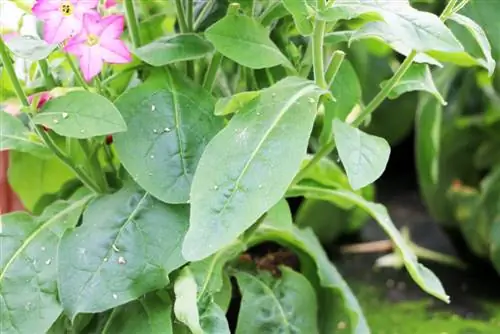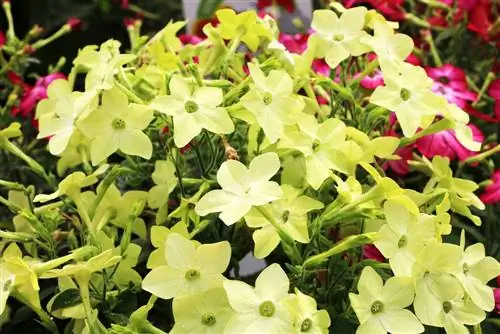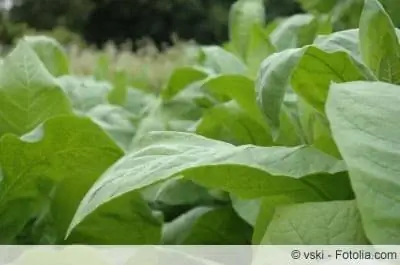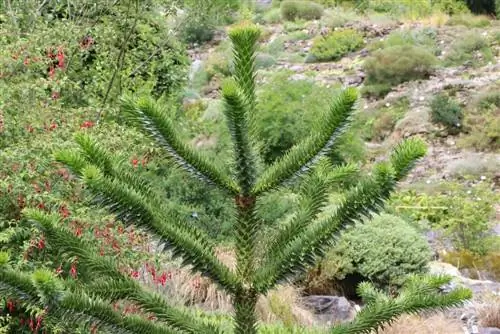- Author admin [email protected].
- Public 2023-12-17 03:39.
- Last modified 2025-01-24 12:45.
When you think of tobacco plants, you immediately wonder whether ornamental tobacco also contains nicotine. In contrast to other representatives of the genus Nicotiana, Nicotiana x sanderae is not suitable for smoking in any form, but thanks to its pleasant scent it is a welcome guest in your own home and on the balcony. Caring for the ornamental plant is quite simple, but certain points should be taken into account.
Ornamental tobacco in portrait
Ornamental tobacco is a hybrid of classic tobacco plants that is specifically aimed at being used as a fragrance and ornamental plant. The plant is quite small in size, but can reach heights of 40 to 60 centimeters. It blooms from May to October and displays lush greenery and a multitude of flowers with five petals. Depending on the species, these come in different colors, from white to reddish to purple, which makes them very popular as a balcony and pot plant, as they thrive very well in isolation.
It can also be planted together with other specimens and spoils the eye with the color of the flowers. The nightshade plant has an intense scent that is only noticeable in the evening. As an annual plant, it is not hardy in any form and should never come into contact with frost, otherwise it can die.
Location
If you choose ornamental tobacco, the location is crucial for the he alth of the plant, especially in the garden. It requires a sunny location that is protected from wind and, if possible, warm. The ornamental tobacco from South America does not tolerate cool temperatures well and the fragrant leaves can suffer in places that are too cold and dark. With Nicotiana x sanderae, the more sun the plant can absorb, the more expansive and larger the flowers will be. The soil should be as follows:
- highly permeable
- nutrient-rich
- sandy
This allows the plant to breathe and develop easily, which above all ensures the plant's intoxicating scent. Due to its size, up to nine plants can be planted per square meter. Tip: Sunny is better for ornamental tobacco. Lots of sun keeps the bush smaller, but the scent intensifies.
Planting in spring

Once the location has been chosen, the ground must now be prepared. Since ornamental tobacco places great demands on the soil and the season, the most important thing to pay attention to is the right fertilizer and the right time. When it comes to fertilizer, tobacco looks forward to nutrient-rich, organic versions that are fresh. Compost made from animal materials is well suited for this purpose, especially horn manure, which is perfectly suited to the needs of the nightshade plant due to its high nitrogen content.
Other animal fertilizers are also possible, but care should be taken not to acidify the soil with the compost. Nicotiana sanderae is only planted in late spring, ideally after the Ice Saints, as the risk of late frost is extremely low here. In any case, you should make sure that there is no longer any danger of frost, as this is fatal for the plant.
The cultivation in detail
- Once you have found a suitable location, decide on the amount of plants you want to plant. Please note: there should be a distance of around 30 centimeters between individual specimens, unless you want to plant across the entire area. In this case, about nine plants fit per square meter.
- Mix a generous amount of compost into the soil. This means the plant can immediately prepare for growth.
- Now place the plants in the ground.
- After planting, you should water the ornamental tobacco thoroughly.
pot planting
Planting ornamental tobacco in a container is very easy due to the small size and short lifespan of the plant. To do this, choose a pot that has a diameter of around 30 centimeters and has some form of drainage. Fill this with either nutrient-rich potting soil or a substrate for balcony plants. Then place the plant in the pot and water the specimen. The best location for this location is a south-facing balcony or window so that the ornamental tobacco has enough warmth and sunshine. You don't have to worry about the tobacco burning, just make sure it doesn't get too much wind.
Pouring
The ornamental tobacco requires sufficient water, but still tolerates drought very well. Nevertheless, Nicotiana sandarae should never become too dry, otherwise the roots will die. The warmer it is, the more often you can water. When watering, just use the soil as a guide, as this is the best indication of the amount of water the plant needs to survive. Please note: Tobacco plants should never be watered from above as too much water on the leaves can cause mildew. Only water from below and generously there. This guarantees a good water supply, especially during prolonged dry periods. Tap water is not a problem for the plants as they have a high tolerance to lime.
Fertilize
Ornamental tobacco is a hungry nightshade plant that should be fertilized frequently. Fertilizing differs from the location in the garden to the container plant. For specimens in the garden, proceed as follows:
- To fertilize, use a complex fertilizer that you can find at any garden center or hardware store. As an alternative, you can use nettle manure in a weak concentration.
- From plantings in spring, fertilize the plant weekly until the end of flowering in October.
- Make sure to only moisten moist soil with the fertilizer. If the soil is too dry, the roots burn and the ornamental tobacco dies.
Fertilize potted plants properly
- As these specimens are in pots, they do not receive any nutrients from the environment, but due to their isolated location they can be well supplied with fertilizer sticks. Commercially available fertilizer sticks that are intended for flowering plants are also suitable for this. This allocation takes place every three months.
- You can also administer a liquid fertilizer weekly. It is best to use an organic fertilizer for this, as ornamental tobacco cannot process inorganic fertilizers so well.
- The third option is slow-release fertilizers. Administer this according to the instructions on the package. This is the simplest method and is just as effective as the two fertilizers mentioned above. Ornamental tobacco is not demanding when it comes to fertilizing as long as it is fertilized regularly.
Cut

Due to its growth habit as an annual plant, pruning is generally not necessary for ornamental tobacco. Annual plants die over the winter and must be replanted or sown the following year. Nevertheless, there are two cuts available for ornamental tobacco, which mainly depend on the location:
- care cut
- Pruning of potted plants
care cut
Pruning is necessary for ornamental tobacco to stimulate flowering and sprouting over the summer and spring. Over time, many of the flowers fade and individual parts of the plant may dry out. You should check these plant parts regularly and if you notice wilted flowers and dried plant material, remove them with sharp scissors.
The plant will not suffer any injuries if there is enough sun and sufficient fertilizer. When pruning, you should make sure to cut as little as possible from the respective area. This stimulates the growth of the plant and ensures he althy growth. If you would like your tobacco plant to be a little bushier and more aromatic, you can trim the tips from time to time. The plant grows very quickly and, thanks to this measure, produces late but intensely fragrant flowers.
pruning
An ornamental tobacco is only pruned if it overwinters in a pot in the winter garden or in the house. Since tobacco continues to grow as long as it does not die due to the rhythm of the seasons, it can sprout heavily and become quite large within one winter. If you want to plant the plant again in the garden the following year or put it on your balcony, we recommend cutting it back. When pruning, pay particular attention to removing branching shoots and generally achieving a uniform shape.
When pruning, only use clean scissors so as not to unnecessarily bruise or injure the shoots. When cutting, follow the original shape from spring and don't be afraid to cut the ornamental tobacco back a lot. Pruning is done shortly before planting in the garden and the plant should receive enough water afterwards. Now be even more careful not to expose the decorative tobacco to any frost.
Propagation
The big advantage of propagating ornamental tobacco is the ease of sowing. Just a few seeds are enough to grow many strong plants with their scent and beautiful flowers. For propagation you can either use seeds from your own specimens or seeds from the market. When buying seeds, be sure to pay attention to the quality, otherwise you will be frustrated by plants that only perform poorly. Sowing takes place in March in the apartment or greenhouse and enables strong tobacco plants that will show off their flowers from the end of May. Propagation takes place in two steps:
- germinating
- Growth of the young plant
germinating
- To germinate the seeds, you need a substrate in addition to the seeds; cactus soil or pots with peat, which are placed in a sunny location within the premises, are best suited for this.
- Ornamental tobacco is a light germinator and for this reason the seeds are placed on the substrate and lightly pressed.
- Moisten the seeds with water, preferably using a spray bottle.
- Keep the substrate moist at all times. To do this, also use a translucent film so that the moisture remains in the substrate.
- It is recommended to change or lift the film daily to avoid mold formation.
- As soon as the first seedlings are visible, the film is removed so that the seedlings can continue to grow.
Young plant
- From mid-April the strongest specimens can be placed in individual pots. For the substrate, refer to the information for planting ornamental tobacco.
- This cultivation enables the strongest specimens to develop good roots within the pots, so that they can be placed in the garden from mid-June.
- It is recommended to put the young plants outside for a few hours during the day and bring them back in in the evening. This hardens them and stimulates the growth of the root system.
Wintering

Due to its high sensitivity to frost, ornamental tobacco must never be kept in the garden over the winter. The winter garden is better for this, but it must never get too cold and the plant must not come into contact with frost, otherwise it will die within a short time. Storing it at room temperature is also not recommended, as the ornamental tobacco would otherwise be a target for spider mites.
If you want to take your specimens out of the garden over the winter, flower pots are ideal for this. This step takes place before the first frost. The plants are stored at a temperature of ten to 15°C and are watered regularly so that the soil remains only slightly moist. Do not overwater the ornamental tobacco, otherwise the roots will suffer.
Tip:
If the winter is very mild, ornamental tobacco seeds can overwinter in the ground. In spring it is possible that the seeds sprout and form new plants.
Interesting facts
Nicotiana x sanderae has a barely perceptible concentration of nicotine, which is mainly found in the leaves of the plant. Since it is a nightshade plant, the plant should not be consumed raw. Nightshade plants contain ingredients such as coumarin, which have a bad effect on he alth if consumed in excess.






